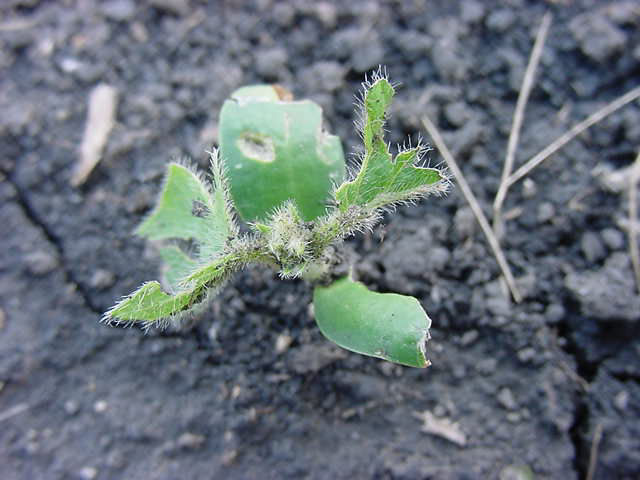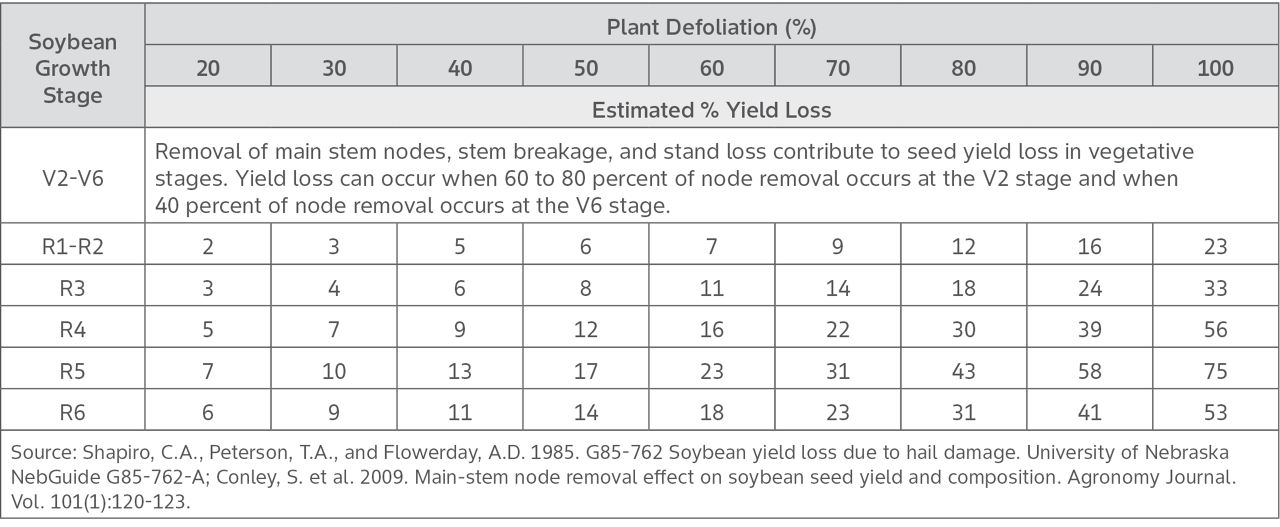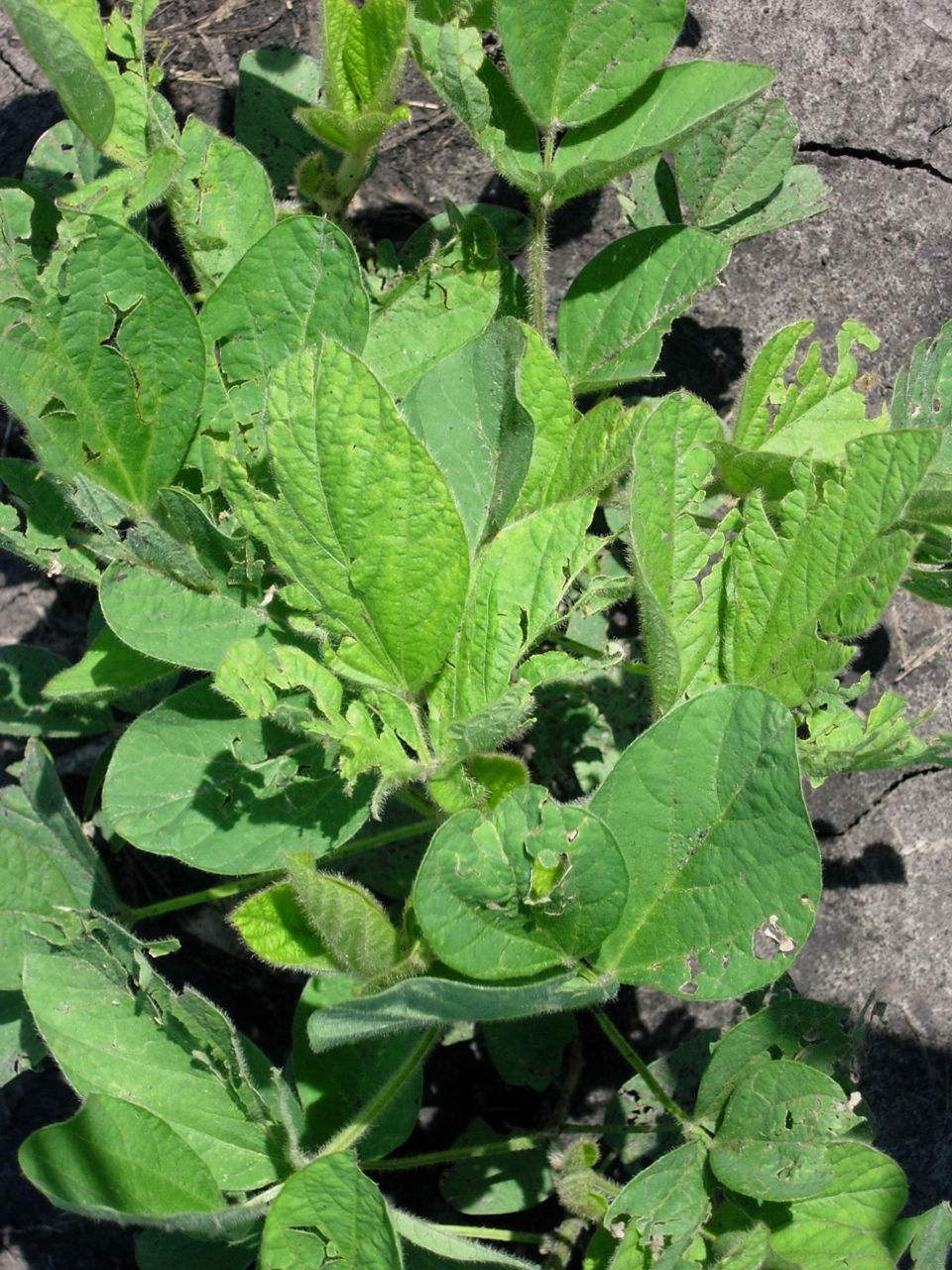5 MIN READ
Impact of Hail Damage on Soybeans
May 27, 2025
KEY POINTS
- Hail causes yield loss through stand reduction, defoliation, terminal loss, stem bruising, and direct pod damage or loss, impacting plant survival and reproductive capacity.
- The growth stage at the time of the hail event greatly influences the potential for damage and recovery.
Hail events can lead to increased weed pressure, further compounding yield losses by creating gaps in the canopy and reducing the ability to compete for resources.
Introduction
While a soybean crop is resilient and can recover from stand, leaf, and terminal loss from a hail event, the potential for yield loss is dependent on the severity and size of the hail, along with the growth stage of growth at the time of the hail event. In addition to soybean growth stage, other variables to consider include quantifying the stand loss, leaf loss, stem or pod damage, and the maturity group of the crop. There is a good chance that soybean plants can recover from hail, and understanding how hail damage can impact the crop can help inform management decisions.
Assessment
Stand Reduction
Soybean plants are most susceptible to stand loss and resulting yield loss during early vegetative growth stages, when plants are small. It is important to wait about four to seven days after a hail event for regrowth to occur prior to evaluating the potential for recovery. To accurately assess potential yield loss from hail, small soybean plants should be evaluated seven to ten days after the storm.1 At that time it should be possible to distinguish between living plants and plants unable to withstand the hail itself or subsequent disease infection. Soybean fields in the vegetative growth stage with a uniform stand of about one half the planted population of about 100,000 plants or more per acre, may realize full yield potential. Because soybean plants can recover by branching out after a hail event, potential yield loss from limited stand reduction during early growth stages is often not of major concern. If severe stand losses occur at these early growth stages or the surviving stand has large areas where skips are more than two feet in diameter, replanting may be the best option. If a severe hailstorm occurs during a reproductive growth stage and a large stand loss occurs, then options are limited other than to destroy the crop and prepare the field for a winter crop or plant a cover crop to protect the soil from erosion and help build the soil for the following summer crop.1,2

Defoliation
If the soybean crop was damaged before flowering growth stages (V2 - V6), plants may not be greatly affected by loss of leaf area (Table 1). Soybean plants have an extraordinary ability to compensate for damaged leaves or lost leaf area. If either the stem apex (growing point at the top) or axillary buds (located at the juncture of the stem and leaves) remain intact after the hail event, new branches and leaves can be produced even if the hail destroyed most of the above-ground foliage.
Table 1. Estimated soybean yield loss from plant defoliation.

Leaf damage usually looks worse than it really is, especially in the first few days after the storm passes. Shredded leaves that remain green and attached to the plant will often continue to produce photosynthates and contribute to seed production and yield. 2

Terminal Loss and Stem Damage
Hail damage that causes the loss of terminal buds can reduce the number of locations where a pod can develop, which then reduces the number of pods that a plant can produce. This reduction in pods directly lowers the yield potential of that plant. The amount of damage is dependent on the crop growth stage at the time of the hail event and the amount of time left in the growing season for the crop to regrow additional terminals. Soybean yield loss estimates due to hail can also be complicated because of potential effects of the damaged areas on the stem. Hail bruises on the lower stem can lead to lodging later in the growing season and result in harvest losses. Stem bruising is also a potential avenue for infection, which can affect plant health and productivity. Poor environmental conditions during the remainder of the growing season can promote the development of diseases and result in additional lodging, leading to more harvest losses. Growers should scout for bacterial diseases, stem rot, and other foliar fungal diseases after a hail event. A fungicide application, either shortly before the hail event or very soon after, may limit disease development, especially in fields with a history of disease problems and under weather conditions conducive for fungal disease development. While a fungicide application cannot recover yield potential lost due to hail damage, it may help increase the plant's stress tolerance after a hail event by helping to control fungal pathogens that readily feast on weak and/or dead plant tissue caused by hail damage. Delaro® 325 SC fungicide delivers long-lasting residual control from both its strobilurin and triazole components for extended performance from each active ingredient against important foliar diseases. Plus, the dual modes of action from Delaro® 325 SC fungicide help ensure you're not promoting further disease-resistance development. To learn more about Delaro® 325 SC Fungicide, visit https://www.cropscience.bayer.us/products/fungicides/delaro and contact your local retailer. Soybean fields that are lodged due to weakened stems or rot should be harvested prior to undamaged fields to help mitigate the amount of yield loss.
Pod Damage
Pod damage due to hail is noticeable when the crop is in the reproductive growth stages from R3 to R5. Damage can be determined by assessing plants and counting how many pods have been removed from the plant, how many pods are still on the plant but opened and the seeds have been damaged, how many of the developing seeds have been damaged, and how many pods have been shattered with seeds on the ground. Plants that are damaged during later reproductive growth stages, are more vulnerable to pod damage, pod removal, or seed loss that will decrease the yield potential of the crop. When trying to determine the yield loss strictly due to developed seeds on the ground after a hailstorm, four beans per square foot on the ground equals a loss of approximately one bushel per acre.3
Maturity Groups, Flowering Types, and Varietal Differences
The maturity group of a soybean crop can influence yield potential loss due to a hail event. Soybean crops use day length to determine when the crop will transition from vegetative growth to reproductive growth. Later maturity group crops delay the crop from moving into the reproductive growth stage, which allows more time for the crop to regrow leaf area and terminal nodes after a hail event. This has a direct influence on the number of terminals that the crop will have to produce pods and subsequently yield. A later maturity group soybean variety has a longer period of reproductive growth than an earlier maturity group variety, which allows more time to develop mature seeds and yield. However, if the hail event occurs late in the growing season, then a late maturing crop may not be harvested yet and can be vulnerable to damage and pod shatter, whereas an earlier maturing crop may already be harvested prior to the hail event.
There are two different flowering types of soybean varieties. The most common type of soybeans planted across the corn belt and north are indeterminate flowering varieties. The indeterminate varieties commonly flower over a three-to-four-week period. If hail damages the crop during the first two to three weeks of flowering, plants can recover from substantial loss of leaves, flowers, and early pods and still produce a crop with limited yield loss. Loss of leaf area causes greater yield losses over more stages of development for determinate varieties than for indeterminate varieties. Determinate flowering varieties, often planted in southern soybean growing areas, have a shorter flowering period, limiting the time to compensate for lost flowers or pods vulnerable to hail damage during flowering. Determinate varieties that have leaf loss due to hail damage during the early reproductive growth stage (R2 to R3) can have a 3% to 17% greater yield losses than indeterminate varieties, depending on the extent of leaf loss.4
Varietal differences in leaf morphology and stem strength can also lead to variations in yield loss due to hail. 4,5
Increased Weed Pressure
Hail damage to the leaf canopy can lead to increased light penetration and late season weed flushes. Depending on when the hail damage occurs during the growing season, an additional post-applied herbicide with contact and/or residual weed control may be an option if the herbicide is labeled for the crop at that growth stage. Always follow the label for application requirements.
If the crop is covered by crop insurance or Agriculture Risk Coverage (ARC), contact your crop insurance agent or your local Farm Service Agency (FSA) office after a hailstorm to check on the limitations, restrictions, and management options for a damaged crop. Expected yield loss caused by hail is the combined damage from the various damage components and is only an estimate. Crop loss can vary from total loss in one part of the field to only a trace of wind and hail damage in another area in a field, so it is important to check multiple locations across each field. True yield loss from a hailstorm cannot be fully determined until harvest. The University of Nebraska-Lincoln Institute of Agriculture and Natural Resources provides a valuable resource to help evaluate potential yield loss due to hail: Hail Know.
Sources:
1Whigham, K., Farnham, D., Lundvall, J., and Tranel, D. 2000. Soybean replant decisions PM 1851. Iowa State University. University Extension. https://store.extension.iastate.edu/
22018. Hail damage to soybean crops. University of Minnesota. University of Minnesota Extension. https://extension.umn.edu/growing-soybean/hail-damage-soybean-crops
3 Licht, M., Sisson, A., Mueller, D., and McGrath, C. 2016. Hail on soybean in Iowa. IPM 79. Iowa State University. Extension and Outreach. https://store.extension.iastate.edu/product/14792
4Ciampitti, I., and Roozeboom, K. 2014. Assessing hail damage on soybeans. Kansas State University. Agronomy eUpdates. https://eupdate.agronomy.ksu.edu/article_new/assessing-hail-damage-on-soybeans-459-2
5Lindsey, L., Geyer, A., Colet, F., and Ortez, O. 2024. Hail damage to soybean and corn. Ohio State University. Agronomic Crops Network. C.O.R.N Newsletter. https://agcrops.osu.edu/newsletter/corn-newsletter/2023-24/hail-damage-soybean-and-corn
Web sites verified 04/15/2025. 1322_34700